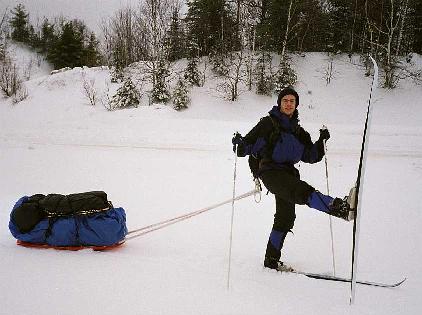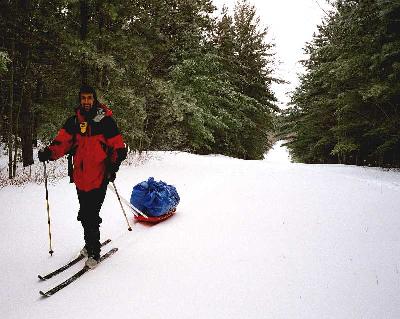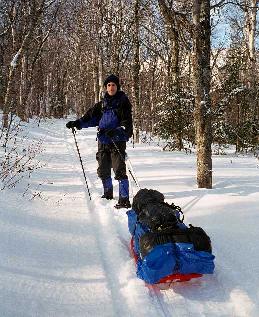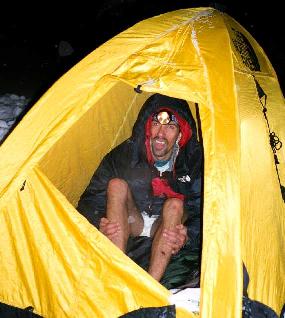
The comfort of the cabin allowed us (or at least that was one of the motivations for staying at a heated shelter rather than bivying at the parking lot) to get out of bed early. A last wholesome civilized breakfast ensued. Robert, being somewhat perky impressed us when he borrowed a knife from Mike and said "would you please remove the cream cheese from the knife?". Here we were few hours from violating all health codes for 5 days, and Robert was picky about the knife!!!. The drive to the trailhead was short, we drove up the Golden Road (parallel to Millinocket Road) for about 8 miles. On the left side of the road, there was a huge parking lot, with a minivan already parked on it. Having learned from previous trips, I parked as close to the road as possible (in case of snow) next to the minivan. Bill, on the other hand, drove straight off the plowed area. Noticing that he was stuck but parked ok, we unpacked knowing that on the return we would have to dig him out.
 After dropping the sled, and testing the skiing conditions, we were
greeted by the sound of a snowmobile. Generally, snowmobile sounds
are not attractive or entice happiness. This case produced a good
sensation since it would mean that some section of the road would be
plowed. A ranger greeted us, told us that the trail to Tongue Pond
Gate (4 miles) was packed. There are two ways to approach the
mountain from the south in the winter. One is via the Tongue Pond
Bridge (the one we did). You ski in 4 miles (2 miles on a small trail
leading to the summer car road, then 2 miles on the road) to Tongue
Pond Gate, then it is another 8 miles to Roaring Brook from there.
The other option is to have someone snow mobile you directly into
Tongue Pond Gate shaving 4 miles off your trip.
After dropping the sled, and testing the skiing conditions, we were
greeted by the sound of a snowmobile. Generally, snowmobile sounds
are not attractive or entice happiness. This case produced a good
sensation since it would mean that some section of the road would be
plowed. A ranger greeted us, told us that the trail to Tongue Pond
Gate (4 miles) was packed. There are two ways to approach the
mountain from the south in the winter. One is via the Tongue Pond
Bridge (the one we did). You ski in 4 miles (2 miles on a small trail
leading to the summer car road, then 2 miles on the road) to Tongue
Pond Gate, then it is another 8 miles to Roaring Brook from there.
The other option is to have someone snow mobile you directly into
Tongue Pond Gate shaving 4 miles off your trip.
We then proceeded to attach the sleds to our packs or harnesses and started the ski in at 9:30am. I was very frustrated because my sled was like a person that did not like sleeping on his or her back, it always turned sideways. I was going crazy, luckily, Robert the expert XC skier, was doing laps and checks on us (It is great to have a professional skier among us, if at anytime you wanted someone to ski back or ahead a mile to check on someone else, no one would hesitate to call on him...). Robert and I redistributed the weight on the sled. The important thing is to keep the heaviest items inside the tub of the sled, this usually means just keeping the pack in the tub. We then attached the snowshoes to the sides of the sled, providing a wide but low center of mass lean mean sled (named the red dear). The most important lesson here is to take your time packing your sled for the lowest center of gravity and the most compactness. The first 2 miles of the ski in take you through a cut-off xc ski trail. That brings you to Tongue Pond Road. From the road, it is about another 2 miles to Tongue Pond Gate. We kept together as a group for a while; unfortunately Bill was having trouble with his sled; at this point the convenience of carrying the TalkAbout (tm) radios proved useful. We split into two groups, but still kept track of each other's progress. Robert and I reached the gate at 11:45am. We did not see anybody on the trail, this is one of the beautiful things of going to Katahdin in the winter. The frozen ponds are absolutely beautiful.
 Tongue Pond Gate is where the fun ended. The trail was only broken
in up to here. We would have to break in the remaining 8 miles. For
the record, the trail is normally broken in by snowmobiles, every few
days, but since we had just arrived after a major snowfall, it had not
been broken in yet (The next day, a ranger met us at roaring brook,
and hence the trail was broken in the next day, chucks had we only
started a day later). At the same time, a virgin trail provides some
benefits no to be had by a used trail. The view of a naked untouched
wilderness pristine road was amazing. Robert and I started breaking
trail for the benefits of others. The trail is not bad, fairly
flat except for some uphills (of course I could be lying). Overall, it
has about 1300 feet of elevation gain in 8 miles. The tricky part of
breaking trail is really finding the old packed trail under the snow;
as soon as you diverge from this unseen covered trail one would dip 6
inches in the powder. This is an obvious problem on the downhills.
Although one can steer oneself to a certain section of the trail, the
sled (if rigged with only one connection point) with a mind of its own
will wonder around sometimes dipping into heavy powder and bringing
you to a full stop faster than air breaks. The opposite case is
equally bad: if the sled does not pull you from behind, it can speed
up faster than you, and since most of us had a single point of attachment
to the sled, namely to the harness haul loop right above the gluteus,
the PVC tubing would tend to probe the deep parts of the inner spirit
if you know what I mean.
Tongue Pond Gate is where the fun ended. The trail was only broken
in up to here. We would have to break in the remaining 8 miles. For
the record, the trail is normally broken in by snowmobiles, every few
days, but since we had just arrived after a major snowfall, it had not
been broken in yet (The next day, a ranger met us at roaring brook,
and hence the trail was broken in the next day, chucks had we only
started a day later). At the same time, a virgin trail provides some
benefits no to be had by a used trail. The view of a naked untouched
wilderness pristine road was amazing. Robert and I started breaking
trail for the benefits of others. The trail is not bad, fairly
flat except for some uphills (of course I could be lying). Overall, it
has about 1300 feet of elevation gain in 8 miles. The tricky part of
breaking trail is really finding the old packed trail under the snow;
as soon as you diverge from this unseen covered trail one would dip 6
inches in the powder. This is an obvious problem on the downhills.
Although one can steer oneself to a certain section of the trail, the
sled (if rigged with only one connection point) with a mind of its own
will wonder around sometimes dipping into heavy powder and bringing
you to a full stop faster than air breaks. The opposite case is
equally bad: if the sled does not pull you from behind, it can speed
up faster than you, and since most of us had a single point of attachment
to the sled, namely to the harness haul loop right above the gluteus,
the PVC tubing would tend to probe the deep parts of the inner spirit
if you know what I mean.
At last, we made it to roaring brook at about 5pm; Mike and Bill joined us at 6pm, they had actually snow shoe some of the steep portions of the trail (which, in retrospect, is not a bad idea; steep climbing with XC skis can be tiring and annoying, to only be doing it due to some stupid ethic or idea that XC skiers don't take off their skis). As soon as we got off the skis did we really notice how much snow was on the ground; the first step was greeted with a "thump", the snow was to my thigh. We then proceeded to make camp. Due to the fact that this was supposed to be a wilderness trip, we had forgone the use of a lean-to (that was already set-up) just 10 feet from us!! We were also rewarded by running water (literally running water, a stream). I had expected that we would have to melt snow all the time, fortunately we found water sources at roaring brook (the roaring brook itself) and a small hole at chimney pond. It was pretty neat being able to hear the roaring brook, its like those nice nature CDs (oh wait, we were in nature). The trip to this brook, which was only 50 feet away, is another story. It is a 45 degree snow descent and climb...Our campsite was great. One of the beautiful things of winter camping is the possibility to explore the architects within us. We took time to carve out a little kitchen, wind protectors, paths, closets, telephone booths (now I am exaggerating).
 One lesson, we learned that day, is the beauty of vapor barriers. By
putting a plastic bag sandwiched between your liners and insulating
sock, your feet stay warmer during the day. The principle is that once
the liner is drenched with sweat (70%), the feet will stop sweating,
and the insulating sock will be dry, and hence insulate better. Some
people even put another plastic bag outside the insulating layer (in
case their XC boots were not fully waterproof, which they were not). The
only caveat to this is to treat your feet well afterwards
(i.e. massage it a bit, let it breath out into the air for a while).
For the record, try this before under a controlled environment, such
as an overnight hike not far from civilization. Another lesson (from
Murray Hamlet), is to let your body breath before getting into the sack.
This allows one to get rid of moisture and reduce condensation.
One lesson, we learned that day, is the beauty of vapor barriers. By
putting a plastic bag sandwiched between your liners and insulating
sock, your feet stay warmer during the day. The principle is that once
the liner is drenched with sweat (70%), the feet will stop sweating,
and the insulating sock will be dry, and hence insulate better. Some
people even put another plastic bag outside the insulating layer (in
case their XC boots were not fully waterproof, which they were not). The
only caveat to this is to treat your feet well afterwards
(i.e. massage it a bit, let it breath out into the air for a while).
For the record, try this before under a controlled environment, such
as an overnight hike not far from civilization. Another lesson (from
Murray Hamlet), is to let your body breath before getting into the sack.
This allows one to get rid of moisture and reduce condensation.